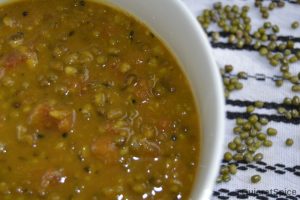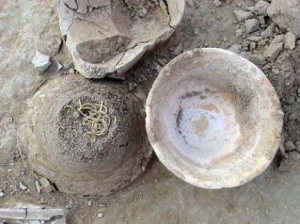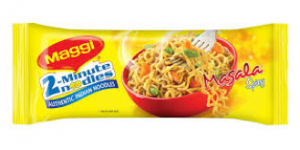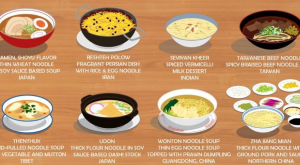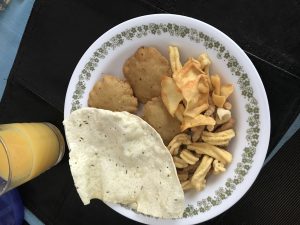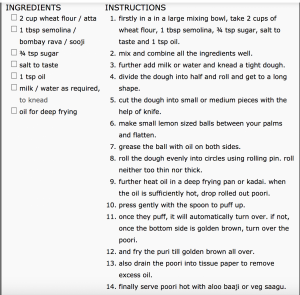A trip to the local Panda Express sparked my curiosity around the historic cross cultural debate between the rice and the noodle. As I walked up to the counter of seemingly endless piping hot Chinese cuisine, I was asked “Would you like rice or noodles?”. My investigative nature drove me to answer a question with yet another question, “Which one is healthier?”. The youthful staff member paused for a second and carefully reflected upon this question before regretfully informing me that she did not have an answer.
Modern times revolve around analyzing how we can be the best version of ourselves. We cannot escape this drive as we go to stores that have shelves packed with self-improvement books, tune in to Netflix with organizational shows featuring people like Marie Kondo, and scroll through Instagram to see perfect portraits of seemingly perfect people. By implementing food (noodles/rice) of other countries like India, China, and Italy we will be able to make America healthier by decreasing the 35 % of the U.S. population classified as dangerously overweight (Parker). As the United States maintains a reputation as one of the unhealthiest nations in the world, it comes as no surprise that people in 2019 see an importance of finding the healthiest options to eat. Analyzing the health factors that go into identifying the most nutritional dishes is far more complex than it seems. In order to answer the question of whether the noodle or rice is healthier, I implemented ideas from books, food blogs, accounts of others, and my personal experiences. The first obstacle was identifying the key traits that classify the noodle and rice. I analyzed the traditional and nontraditional forms of these dishes which included wheat noodles, rice noodles, and instant versions of rice/noodles. The second obstacle was studying the nutritional data within these dishes in order to classify food as healthy and unhealthy. Lastly I applied this research into terms that challenges the reader to apply healthy food into their own lives and their communities. Throughout this paper implemented traces of the culture behind each dish as a means to provide a wholistic understanding of rice and the noodle.
The traditional noodle definition contains themes of the literal materials and methods used to compose noodles, however these descriptions do not address the cultural importance noodles hold in the lives of many. Cambridge defines the noodle as “A strip, ring or tube of pasta or a similar dough, typically made with egg and usually eaten with a sauce or in a soup” (Cambridge Dictionary). Although this definition makes an effort to encompass multiple cultures by using wording like similar dough, it fails to address how people view the noodle. Beyond the basic use of noodles as food for nutrients, noodles play a crucial role in representing various cultures, people, and values around the world. Indians eat Paysasam, noodle pudding, to satisfy their interesting palate as they combine ginger, sugar, and pasta into a sweet and savory concoction. Italy’s rich artistic heritage is expressed through Italian pasta which resemble pieces of artwork that come in a variety of interesting shapes and sizes. A specific example of the Italian’s creative nature can be seen through Orecchiette, which is mixture of durum wheat and water molded into a shape that resembles a small ear (An Intro to Italian Pasta). Many Chinese traditions are directly related to noodles as a means to connect history and food. China’s relationship to the noodle is expressed through the variety of different noodles that are cooked and eaten depending on the occasion – long life noodles for birthdays, dumplings for Summer Festivals, and my personal favorite the old friend noodle for when you see an old friend (Zhang, 2). These examples speak to the noodle’s breadth which spans the entire world, however each geographic region maintains a different perspective on this dish.
Similar to the noodles expansive network of connections, rice’s influence can be found on all seven continents and in space. Rice can be defined as “the small brown or white seeds produced by a grass plant that are a major food source in many countries, or the plant itself, which is grown in warm, wet places” (Cambridge Dictionary). To further understand the context of rice beyond Cambridge’s simple definition, the context and culture of eating rice must be understood. NASA’s space exploration has implemented the use of this grain since the iconic Apollo 11. Rice has been used to provide freeze dried food for astronauts as well as farming potential on other planets. By analyzing a rice consumption map I learned that rice is eaten in all continents however, major rice consumption is centralized around Western Africa, East Asia, the Indies, and South America (Muthayya). Although I live in the United States, coming from an Indian background has shaped my perspective on white rice. It has maintained its position as a staple dish in our family for generations through its versatility and ability to be mixed with numerous things. In my household dinner is the largest meal of the day where my whole family reconvenes to enjoy a two to three course meal. The first course tends to be saac and rotli, which entails vibrant vegetarian dishes that could include beans, okra, or potatoes and warm thin Indian bread. The second course revolves around white rice which can be mixed with saac, ghee (Indian butter), or dhar (tomato based soup). The last course is typically a dessert or sweet to counteract the first two spicy courses. This provides an in depth analysis of the importance of rice within the Indian household and diet.
Although there are regional influences that impact diet, virtually all of Italy follow the Mediterranean diet which allows them eat “healthy”. A healthy diet consist of a balanced intake of food that includes a large consumption of vegetables, fruits, grains, and seafood (Slide 15 Intro to Italian Food). Fruits, vegetables, and fresh Italian pasta serve as banks full of vitamins, minerals, and fiber. Vitamins and minerals function throughout the body as they can provide aid ranging from healing wounds on the macroscopic level to repairing cell damage on the microscopic level. Classic Italian pastas, also known as whole grain noodles, come from a combination of duram wheat, water, and the occasional egg. Duram wheat acts as a double edged sword which allows the noodle to meet ideal stickiness while adding nutritious fiber content to the pasta. Fiber plays a crucial role in maintaining the digestive system to prevent constipation and even reduce risk of bowel cancer. This is one example of how the Italian noodle is considered to be healthy.
With the rise of gluten allergies and gluten free diets, many have turned to wheat substitutes like the historic Chinese rice noodle. Thomas Talhelm’s study on rice theory exemplifies the diversion of noodles within China that led to the production of this dish. The expansive nature of rice and noodles have shown that these dishes can be created differently based on the geographic location, which plays a role in access to certain crops and equipment. China is separated by the Yangtze river which runs from the western side of China all the way to the east in which the river meets the ocean. Thomas noted that people in North China tend to grow wheat, corn, millet, and soybeans. Lo Mein and Chow Mein are examples of staple dishes in the north that were directly influenced by the accessibility of certain crops like wheat. People in Southern China grow rice (July 24 Lecture). Rice noodles became a stable dish of Southern China because rice and flour were the most abundant materials available for cooking. Rice noodles share a similar calorie and fat content in comparison to the Italian wheat noodle and northern Chinese Lo Mein. The most significant differences between the gluten free noodle and gluten noodle fall on the protein, vitamin, and mineral content. The rice noodle has 4 times less protein than the wheat noodles. Protein is essential for building and repairing tissues, so people who are attempting to gain muscle should opt for the wheat noodles (Osterweil) . Even if bodybuilding is not on the forefront of your goals, protein is vital for the production of enzymes, hormones, and other chemicals so it is still important. Traditional noodles have iron, thiamin, niacin, and folate which all function as a means to repair damage in the body and maintain development, however these vitamins are absent in rice noodles. There are also more minerals in traditional wheat noodles which play a role in maintaining blood pressure and other homeostatic systems (HR, BP, Immune System) (Brookshier). Although the rice functions as a substitute for wheat, many of the nutritional contents that make noodles healthy are lost. If rice noodles were paired with vegetables and meat, the nutritional value would match that of the traditional gluten noodle. The noodles provide similar calorie, fiber, and carbohydrate content, while the vegetables and meat add the key protein, vitamins, and minerals. If given the option of rice noodles or traditional noodles I would personally opt for the traditional wheat noodles due to the added health benefits.
Now that we have analyzed the health differences between two forms of noodles, it is time to look at the difference between brown rice and white rice. Coming from an Indian household, I hold a slight bias towards white rice. When I asked my grandfather about his thoughts on white rice he explained that it was extremely healthy and provided great sleep. As I looked into the science behind this sleeping food phenomenon, I realized that white rice’s high glycemic index causes our bodies to break down the food really fast. This means that we have a spike in our blood sugar. Similar to the saying what goes up must come down, the enormous drop in blood sugar accounts for the drowsiness we experience. The rapid increase and decrease of blood glucose can be harmful for people at risk of type 2 diabetes, who want to focus on maintaining a healthy blood sugar level. Although brown rice does not have the NyQuil effect, it does contain more fiber and protein allowing for the added health benefits similar to that of the traditional gluten noodle. In order to catch up with the brown rice’s nutrient content a lot of white rice is enriched as a means to close to health benefit gap between these two foods (Allan). Going against my own culture, I believe that brown rice is healthier because it contains natural vitamins and minerals as opposed to white rice which is enriched. These two forms of rice have sparked controversy all over the world, including China in which there is a strong debate as to which one is superior.
As a means to compare rice and noodle, which can be found in dishes from cultures all over the world, I chose to focus on China because they have strong ties to both foods. Similar to my introductory dilemma of choosing rice or noodles at panda express, there are a lot of factors that come into play which make this task of deciding the healthier dish relatively daunting. Specifically analyzing fried rice and chow mein of panda express provides for an in depth comparison that highlights the similarity of calories, fat, sodium, and carbs. The noodles contained a higher cholesterol level which could be harmful because cholesterol has been linked to an increased risk of heart disease. The noodles also had higher levels of protein and fiber which has been linked to muscle repair/growth and healthy digestion, respectively. Rice contained a lower sugar content which means that the after eating the fried rice the blood sugar will not spike as quickly as the noodles (fatsecret). Based on these findings, I would say the noodles and rice have their own minor advantages and disadvantages, but neither is an outright healthier choice. Rather than choosing rice over noodles, or vice versa, it is more important to analyze the form of rice/noodles and the food it is served with. Eating rice and noodles paired with lean protein, vegetables, and low sodium sauce is a healthy choice over the typical low vegetable, high protein, and salty sauce dish typically found in the United States. If given the choice I would prefer a bowl of whole grain Chinese noodles over the white counterpart because it is typically less processed and full of natural vitamins.
The Guangxi-vinegar noodle is a specific example of how the Chinese culture places an emphasis on the usage of food as a form of medicine. There is a folk tale surrounding the Guangxi vinegar-pepper noodles and how this noodle can provide aid for the sick. The story describes a relationship between a teahouse owner and a regular customer who comes to the shop every day. When the customer did not make an appearance one day the shopkeeper followed up on his friend and realized he was sick. He quickly rushed home and prepared these noodles by using making noodles with a vinegar pepper sauce hot enough to make a sweat. Similar to how the Guangxi vinegar pepper noodle was brought to the friend when he was sick, these spicy noodles are being used today to have close friends/family sweat away illness (Zhang, 2). Although these noodles are not eaten on a regular bases they provide a method of healing in specific cases. I am aspiring to become a pediatrician later in life so I’m drawn to the idea of using food to cure illness. This folk tale highlights how the noodle has impacted the healthcare system by providing a clear example of the usage of food as medicine. I was not able to find a similar example of rice as medicine, which speaks to the noodles use in Chinese culture as a healing agent.
The importance of living contained a chapter discussing the Chineese’s perception of food and medicine. Lin Yutang emphasized the importance of using food before resorting to medicine in the quote “A true doctor first finds out the cause of the disease, and having found that out, he tries to cure it first by food. When food fails he prescribes medicine”. This quotes directly applies to all healthcare professionals who have the capacity to heal. In the Indian culture, a herbal tea concoction is given to people having stomach problems. As a child my family would make the tea first and if the home remedy did not fix the problem we would go to see a doctor. Many cultures around the world practice this form of healing, and I believe that the United States should seek to adopt this way of thinking as well.
In America’s hustle and bustle society consumers have placed an emphasis on making food quickly and easily. Food manufacturers responded by creating the highly controversial instant noodles and rice which trade convenience in place of nutritious. Ramen noodles, similar to all packaged instant noodles, are essentially fried noodles with high levels of salt to increase the shelf life. Aside from the ease of cooking these noodles, many people have implemented instant noodles into their diets because of the inexpensive price. The average packet cost a consumer about 13 cents which is an unbeatable price for a meal (Yoon). As a means to combat the rise of unhealthy cheap food, the Gansu government has taken initiative to teach people in impoverished communities to cook a bowl of noodles for around 8 yuan or $1.50. Lanchou beef noodles have a few essential ingredients including flour and water for noodles, spice-braised beef, cilantro, green onions, and hot chili oil (Xu). Armed with this noodle recipe people are fighting back against poverty by cooking noodles at home and even opening up shops. Instead of settling for unhealthy instant noodles with countless preservatives and ridiculously high sodium levels, these people are making their food from scratch so they know exactly what is going into these noodles. Most of the preservatives used in instant noodles have been approved by the FDA because of the lack of evidence around harmful short term effects, but we do not know the implications of using these drugs long term. I want to challenge others to focus on avoiding instant noodles by implementing cooking practices like the Chinese as a means to make fresh healthy food. When you are in the store looking for dinner items, pick up a bag of flour, eggs, beef, and sauce and attempt to cook the Lanchou noodles instead of reaching for the simple pack of ramen noodles. Your body will thank you for it in the long run.
This paper focused on addressing the longstanding debate around rice and the noodle in relation to healthiness. I have been curious about this topic for a long time, but the research I conducted proved that there is no superior grain. Both have their own slight advantages and disadvantages but there is no specific champion. I personally believe brown rice is the healthiest option, however the noodle is a strong competitor because it has increased protein and fiber. The noodle and rice come in many variations that are enjoyable by people who eat gluten and those who are gluten free, however if given the choice I would choose gluten noodles because they have more nutritional value. When analyzing dishes there are many things to take into consideration from the culture of the dish to the specifics of the sugar content. Health is a broad term that applies to maintaining our health as well as fighting illness. The Chinese have highlighted the importance of viewing food as a source of healing through the Guangxi vinegar-pepper noodle. America should seek to take notes from societies like China, who use noodles as a mean to better impoverished areas. Although healthy food in grocery stores tend to be expensive, people in China are fighting back against unhealthy cheap food by cooking fresh foods from scratch. In order to tackle poverty, we must first tackle the food that is being provided to low income areas.
Work Cited Page
“5 Things You Never Knew about Instant Ramen.” The Daily Californian, 8 May 2018, http://www.dailycal.org/2014/09/18/5-things-never-knew-instant-ramen/.
Brookshier, Stephanie. “Nutritional Differences in Rice Noodles vs. Regular Pasta.” Healthy Eating | SF Gate, 21 Nov. 2018, https://healthyeating.sfgate.com/nutritional-differences- rice-noodles-vs-regular-pasta-1943.html.
“Chow Mein.” Calories in Panda Express Chow Mein and Nutrition Facts, https://www.fatsecret.com/calories-nutrition/panda-express/chow-mein.
“Find Definitions, Meanings & Translations.” Cambridge Dictionary, https://dictionary.cambridge.org/us/.
“Fried Rice.” Calories in Panda Express Fried Rice and Nutrition Facts, https://www.fatsecret.com/calories-nutrition/panda-express/fried-rice.
Muthayya, Sumithra & Hall, Jessica & Bagriansky, Jack & Sugimoto, Jonathan & Gundry, Daniel & Matthias, Dipika & Prigge, Shane & Hindle, Peter & Moench-Pfanner, Regina & Maberly, Glen. (2012). Rice Fortification: An Emerging Opportunity to Contribute to the Elimination of Vitamin and Mineral Deficiency Worldwide. Food and nutrition bulletin. 33. 296-307. 10.1177/156482651203300410.
Osterweil, Neil. “The Benefits of Protein.” WebMD, WebMD, https://www.webmd.com/men/features/benefits-protein.
Parker, Najja. “Is the US the Unhealthiest Country in the World?” Ajc, The Atlanta Journal- Constitution, 28 Dec. 2017, https://www.ajc.com/news/world/the-the-unhealthiest- country-the-world/COrmAHcbJ19vswVJg5UXsJ/.
Xu, Yuhan. “China Plans To Make Scratch From Noodles.” NPR, NPR, 4 Apr. 2019, https://www.npr.org/sections/goatsandsoda/2019/04/04/709061176/china-plans-to-make- scratch-from-noodles.


